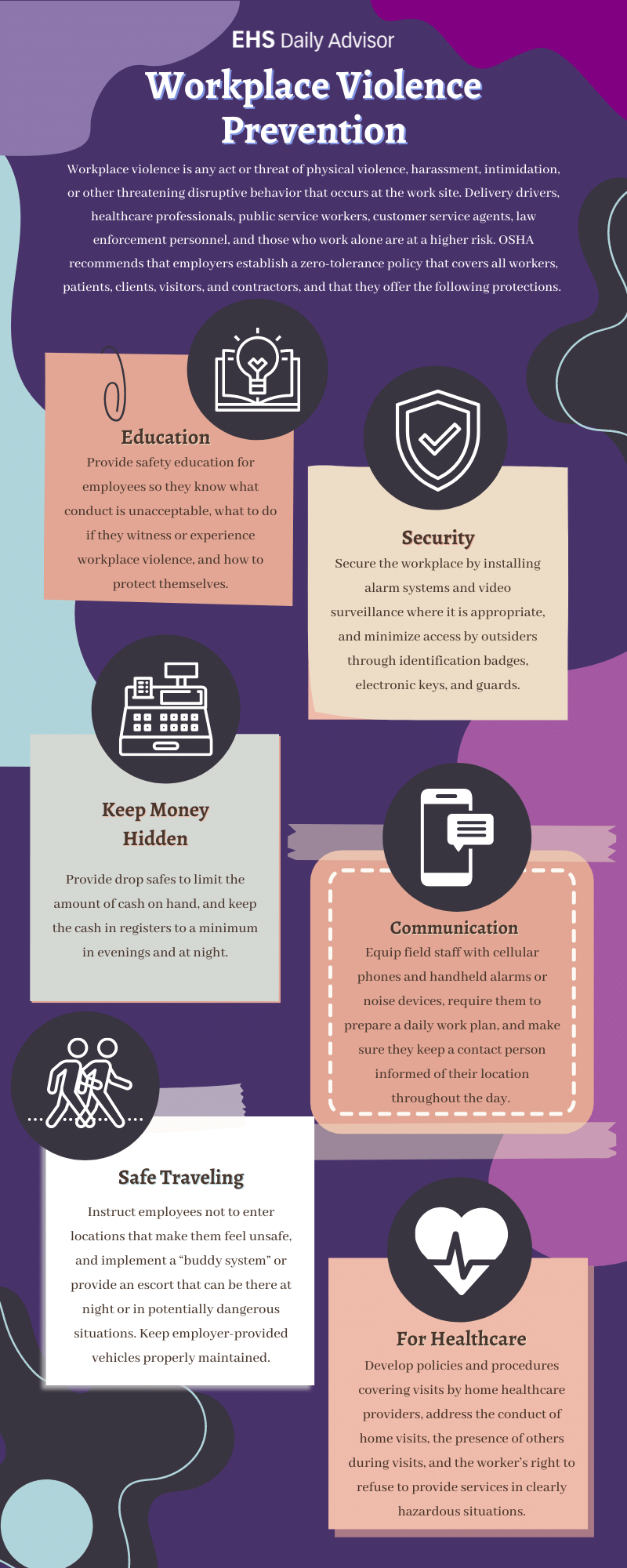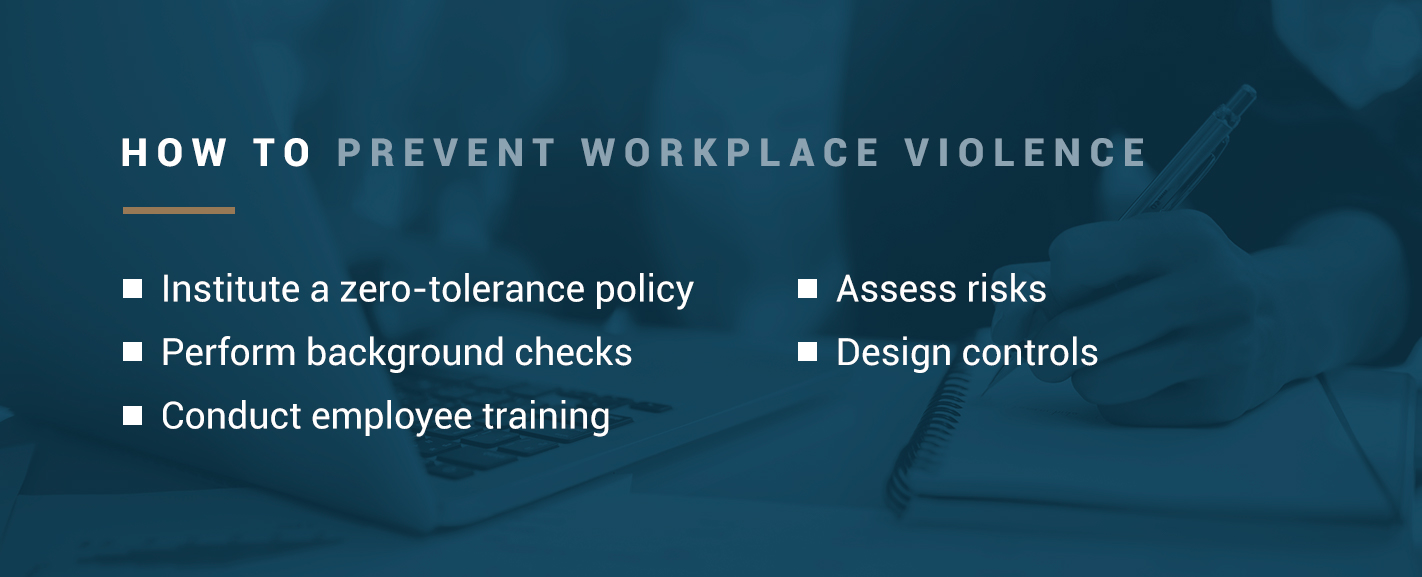Adjusting California Workplace Violence Prevention Methods for a Changing Workforce
The Essential Function of Training and Understanding in Ensuring Reliable California Office Physical Violence Prevention Programs
In the world of work environment safety and protection, the value of executing durable physical violence prevention programs can not be overemphasized. Specifically in California, where rigorous regulations demand a positive strategy to protecting staff members, the duty of training and awareness becomes a foundation of effective avoidance approaches. By diving into the intricacies of work environment violence risks, creating customized training programs, fostering a society of alertness, and establishing clear coverage and response methods, companies can mitigate possible dangers and safeguard their labor force. The true efficiency of these programs lies not only in their creation yet likewise in the ongoing evaluation of their impact and versatility to developing hazards.
Comprehending Office Violence Dangers
In assessing work environment violence dangers, it is crucial to thoroughly examine the specific elements that contribute to prospective dangers within the business setting. High-stress sectors, such as healthcare and law enforcement, may have a higher risk of violence due to the emotionally charged scenarios staff members encounter.
Furthermore, private variables, such as previous background of physical violence or material misuse concerns, can also play a considerable role in boosting the possibility of work environment physical violence. It is crucial for companies to perform thorough threat assessments that take into consideration these various elements to produce a thorough avoidance strategy. By recognizing and recognizing the particular risks existing in the work environment, companies can proactively attend to potential hazards and produce a safer setting for all employees.

Developing Worker Training Programs
Effective workplace physical violence avoidance programs require the development of thorough worker training programs tailored to the specific threats and requirements of the organization. These training programs need to include various facets, consisting of recognizing very early indication of possible physical violence, de-escalation techniques, problem resolution techniques, and reporting procedures.
To start, it is important to conduct a detailed danger assessment to determine the distinct susceptabilities within the organization. This analysis ought to educate the material and emphasis of the training programs, guaranteeing that staff members are furnished with the knowledge and skills essential to respond and protect against to potential dangers efficiently.
In addition, training sessions ought to be interactive and interesting to make best use of retention and application of the information supplied. Making use of real-life situations and simulations can aid employees practice their actions in a regulated environment, improving their readiness in case of a crisis.
Routine support of training through refresher programs and updates is additionally essential to make sure that staff members remain alert and aggressive in preserving a risk-free workplace. By buying well-designed and tailored training programs, organizations can equip their staff members to play an energetic duty in preventing workplace violence.
Promoting a Culture of Understanding

Key to fostering a culture of understanding is leadership buy-in and more commitment to prioritizing the security and wellness of all workers. Leaders must establish the tone by continually connecting the relevance of office safety and security, giving sources for training, and urging open discussion concerning any type of worries associated with work environment violence - california workplace violence prevention. Additionally, organizations can carry out understanding campaigns, such as e-newsletters, workshops, and posters, to maintain over here the subject at the leading edge of employees' minds
Implementing Coverage and Feedback Treatments
To develop a durable framework for handling work environment violence occurrences, companies must develop clear and effective reporting and action treatments. Coverage treatments must lay out just how staff members can report any kind of potential or actual violence, harassment, or threatening behavior. By implementing comprehensive reporting and response treatments, companies show their dedication to keeping a safe and risk-free work environment for all workers.
Evaluating Program Effectiveness
Analyzing the influence and results of workplace physical violence avoidance programs is necessary for companies to evaluate the effectiveness of their campaigns and make notified choices pertaining to program improvements. Evaluation methods must focus on gauging the program's capability to avoid and minimize events of workplace physical violence, as well as the total effectiveness of training and recognition efforts. One means to assess program performance is with assessing occurrence reports and patterns prior to and after program application. A decline in the number of reported occurrences or a shift in the types of cases happening might indicate that the program is having a positive influence.
Additionally, carrying out studies or meetings with staff members can provide important insights into the viewed performance of the program and locations for renovation. Responses from employees who have undergone training or been associated with an office violence event can aid companies recognize strengths and weaknesses in their avoidance initiatives - california workplace violence prevention. Consistently updating and evaluating program performance metrics based this article on examination results is critical for maintaining a aggressive and effective workplace violence avoidance program in The golden state
Conclusion

Furthermore, private aspects, such as past history of violence or compound abuse issues, can likewise play a considerable role in enhancing the probability of work environment violence. Leaders should set the tone by consistently interacting the significance of work environment safety and security, supplying resources for training, and motivating open dialogue about any kind of concerns related to workplace physical violence.Evaluating the influence and results of workplace physical violence avoidance programs is vital for organizations to determine the performance of their campaigns and make notified choices regarding program improvements. On a regular basis upgrading and reviewing program efficiency metrics based on assessment outcomes is crucial for keeping a reliable and proactive office violence prevention program in California.
By recognizing the risks connected with workplace violence, establishing training programs, promoting a culture of recognition, and on a regular basis evaluating program effectiveness, organizations can develop a more secure job setting for staff members.